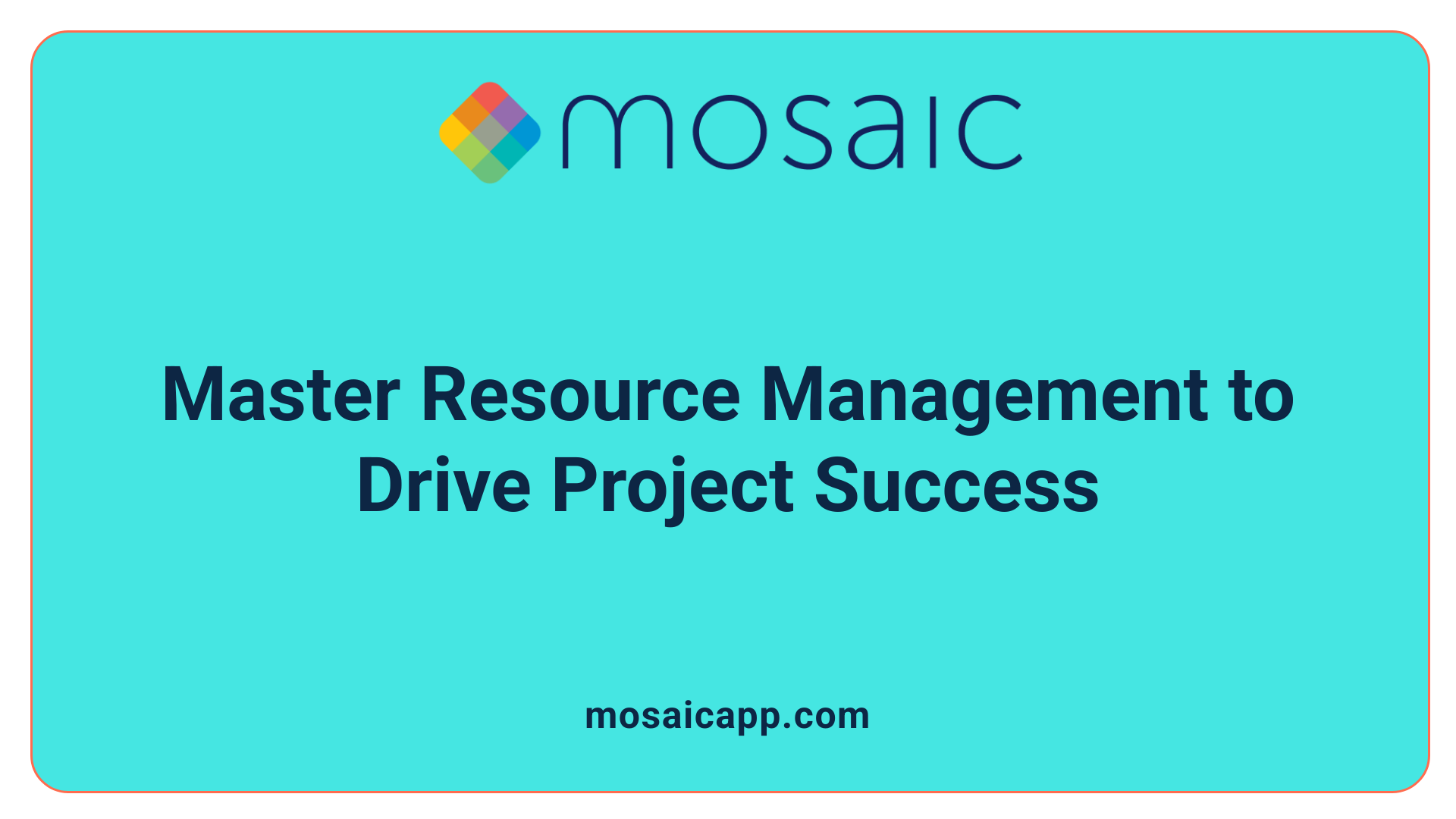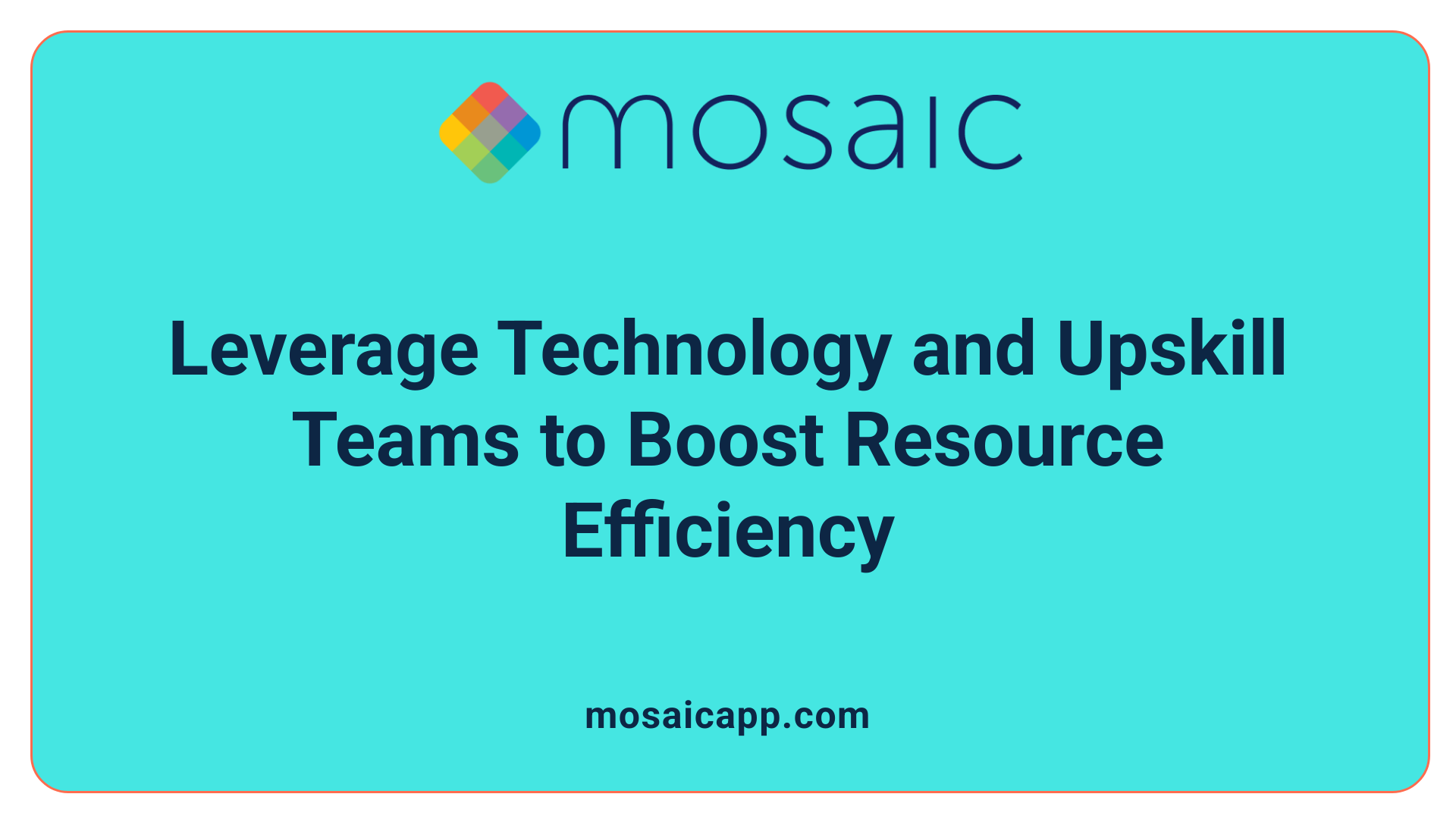The Quiet Margin Erosion Lurking in CFO Dashboards
In today’s complex business environment, CFOs face the daunting task of safeguarding profitability amid myriad operational challenges. One hidden threat that quietly erodes margins is the underutilization of resources within project management—a phenomenon that often goes unnoticed until financial consequences become stark. This article dives deep into how improper resource management not only impacts project delivery but also imperils corporate margins, illustrating why CFOs must embrace integrated, data-driven strategies to regain control of profitability and drive sustainable growth.
Understanding Resource Management and Its Critical Role in Project Success

What is resource management in project management?
Resource management in project management involves systematically planning, allocating, and overseeing various resources—such as human personnel, equipment, materials, and finances—to ensure successful project completion within constraints like time and budget. Developing a resource management plan provides visibility into team workloads, balances resource utilization, and prevents issues like overwork or underutilization.
Effective resource management employs techniques such as resource allocation, forecasting, leveling, and tracking to optimize available resources, enhancing team performance. Proper planning, often supported by work management platforms, facilitates efficient scheduling, monitoring, and adjustments, reducing risks of delays, cost overruns, and burnout.
Why is resource management important for successful project planning and execution?
Resource management is crucial because it ensures necessary resources—personnel, budget, technology—are available when needed, preventing project delays and bottlenecks. By optimizing utilization, it reduces costs and maximizes organizational value. It empowers project managers to forecast requirements accurately and monitor progress to boost productivity.
Poor resource management can cause project failures, insufficient funding, and misaligned efforts, jeopardizing outcomes. Robust resource management practices maintain resource balance, support strategic objectives, and secure overall project success.
What are the key steps involved in resource management planning within project management?
Resource management planning begins with identifying necessary resources and estimating their quantities and timelines. These are matched to project tasks based on skill sets and availability. Preliminary plans, such as creating wireframes with unnamed resources, help forecast needs early.
Scheduling and budgeting ensure efficient allocation. Constant monitoring seeks early detection of bottlenecks or overcommitment. Adjustments address delays, scope changes, or unforeseen issues. Post-project analysis informs improvements for future efforts. Using resource management tools and continuous evaluation further strengthens utilization, delivery, and profitability.
Optimizing Limited Resources: Techniques and Tools for CFOs and Project Managers
How can project managers optimize the allocation of limited resources during planning?
Project managers can optimize limited resource allocation by strategically prioritizing tasks based on deadlines, importance, and impact on core project milestones. This ensures critical activities receive focused attention. Techniques like resource leveling and smoothing adjust schedules to avoid over-allocations and reduce burnout among team members. Continuous tracking of resource utilization helps identify underused or overloaded capacities, enabling data-driven decisions that boost efficiency and reduce costs.
A clear project plan supported by defined resource availability and real-time data monitoring is key. Incorporating advanced project management software allows constant visibility into workload distribution and potential conflicts, allowing timely reallocation when needed.
What tools and techniques are commonly used for resource management and planning in projects?
Common tools include Gantt charts, resource histograms, and resource calendars, which help visualize resource assignments over project timelines. Techniques such as resource leveling algorithms and capacity planning optimize usage by automatically adjusting schedules to prevent overallocation or idle time.
Modern software platforms like Microsoft Project, Primavera, and cloud-based options including Motion, ClickUp, Hive, Float, and Smartsheet offer automation features and real-time workload insights. These tools allow proactive alerts for delays, automated task assignments, and dynamic schedule adjustments, reducing manual effort and improving efficiency.
How do resource management and project scheduling interrelate?
Resource management ensures that personnel, equipment, and facilities are available and properly allocated according to the project schedule. Scheduling outlines tasks and deadlines, while resource management coordinates availability to meet those demands.
Their interdependence means that proper alignment avoids bottlenecks and delays by forecasting and adjusting resource allocation as needed. This integration leads to realistic timelines, better resource utilization, and successful project completion within budget and scope constraints.
Below is a summary of discussed concepts:
| Aspect | Description | Benefits |
|---|---|---|
| Prioritization | Focus on critical tasks and milestones | Ensures essential activities get resources |
| Resource Leveling & Smoothing | Adjust schedules to balance workload | Reduces burnout and overallocation |
| Visualization Tools | Gantt charts, histograms, calendars | Enhance clarity on resource allocation |
| Automation Software | Platforms like MS Project, Smartsheet | Increase efficiency and real-time insights |
| Integration of Scheduling | Align scheduling with resource availability | Prevents bottlenecks and delays |
Optimizing limited resources involves a combination of clear planning, effective tools, and ongoing management to navigate constraints and meet project goals efficiently.
Challenges in Resource Management: From Visibility Gaps to Skill Shortfalls

What challenges commonly arise in resource management during project planning, and how can they be addressed?
Resource management during project planning often encounters multiple challenges that can undermine productivity and project success. One primary issue is the limited visibility into resource availability, which makes it difficult to allocate team members effectively and avoid overbooking. This lack of transparency is especially problematic in environments where resources are shared across multiple projects, causing conflicts and overallocation that contribute to burnout and reduced output.
Another challenge is skill gaps within the workforce that can delay progress or result in lower-quality work. Unrealistic deadlines further exacerbate these issues, pressuring teams to deliver under constraints that do not reflect actual capacity and capabilities. Poor communication, notably in remote or distributed teams, diminishes coordination and intensifies resource conflicts, leading to inefficiencies and low morale.
Addressing these challenges requires a multifaceted approach:
Continuous Monitoring and Real-Time Data Use: Leveraging modern ERP and cloud-based platforms allows project leaders to track utilization rates and availability in real time. This transparency helps prevent overallocation by providing a clear snapshot of team capacity.
Open Stakeholder Communication: Regular updates and early conflict resolution through cross-functional communication ensure resources are matched to priorities appropriately, enhancing alignment with organizational goals.
Investment in Workforce Training: Upskilling staff minimizes skill gaps, ensuring team members are prepared to handle their assigned tasks when projects demand it.
Flexible Scheduling and Prioritization: Adopting adaptive scheduling techniques accommodates unexpected changes and balances work distribution, maintaining productivity without overloading individuals.
The adoption of these strategies promotes healthier workloads, maximizes revenue-generating billable hours, and enhances project delivery quality, ultimately safeguarding profitability and team morale.
The CFO’s Perspective: Linking Resource Utilization to Financial Health

How Do Utilization Rates Affect Revenue Generation?
Resource utilization rates provide a critical measure of how effectively a team’s time is allocated to revenue-generating activities. Ideally, utilization rates should range between 80-90%, signaling a well-balanced workload that maximizes productivity without causing burnout. Staying in this range helps ensure the team remains financially efficient by dedicating most of their hours toward billable projects.
What Are Typical Billable Utilization Rates Across Roles?
Billable utilization varies significantly by role. Producers generally maintain about 75% billable utilization, reflecting their direct involvement in revenue activities. In contrast, support roles and managers have lower billable utilization rates, typically 35-40%, due to non-billable responsibilities such as oversight and administration. Accurately calculating these rates — by dividing total billable hours by total available hours — provides CFOs with essential insights into workforce productivity.
Why Are Average Billable Rate and Average Cost Per Hour Important?
The Average Billable Rate (ABR) measures revenue earned per billable hour and is a vital indicator for spotting profitability troubles if it declines. Simultaneously, the Average Cost Per Hour (ACPH) reflects the actual labor cost per hour when considering total annual workforce expenses. Comparing ABR with ACPH allows CFOs to assess if service prices adequately cover costs and contribute positively to margins.
How Does Delivery Margin Influence Profitability and Margin Loss?
Delivery margin—calculated as ((Adjusted Gross Income – Delivery Costs) / Adjusted Gross Income) x 100—quantifies profitability after deducting delivery expenses. Maintaining this margin within a 55-75% range is critical to safeguarding profits. Manufacturing data shows companies can lose up to 80% of their margin between quoting and delivery due to execution breakdowns, emphasizing the importance of strict margin governance and cost control through real-time tracking and integrated systems.
These metrics collectively empower CFOs to connect resource utilization directly to financial health, supporting strategic decisions that preserve margins and drive sustainable growth.
Digital Transformation: Closing the Data Gap for Margin Protection
Role of Cloud ERP and Modern Analytics in Real-Time Resource and Margin Visibility
Cloud ERP systems, such as those offered by Oracle, play a pivotal role in providing CFOs and finance leaders with real-time data visibility. These platforms enable tracking of resource utilization rates—ideally between 80-90%—by seamlessly aggregating billable and non-billable time data. This visibility allows businesses to monitor profitability more precisely through metrics like Average Billable Rate (ABR) and Delivery Margin, facilitating improved decision-making and rapid response to market changes.
Integration of Quoting, Engineering, and Fulfillment for Margin Governance
One of the major challenges in protecting margins arises from disconnects between quoting, engineering, and fulfillment processes. Digital transformation efforts focus on connecting these areas into a single, transparent pipeline. Engineering codifies operational constraints and knowledge, ensuring quotes reflect real-world capabilities and reduce costly rework. This integration supports a comprehensive margin governance framework, addressing issues such as scope creep and underestimated costs.
Building a Single Source of Truth for Profitability and Margin Tracking
Creating a unified data platform that integrates quoting, fulfillment, and financial systems establishes a robust single source of truth. This enables accurate tracking of profitability from quote to delivery, highlighting margin variance in real-time. Such transparency is essential for operationalizing margin governance, where shared KPIs like quote-to-delivery variance and rework rates are consistently monitored across teams.
Use of Embedded Analytics and Proactive Margin Prevention
Embedded analytics within cloud ERP platforms empower organizations to move beyond static retrospective reporting. Real-time analytics enable proactive identification of margin risks, supporting early interventions to prevent erosion. By focusing improvement efforts initially on high-leak areas and scaling across the enterprise, companies can safeguard margins amidst economic uncertainties.
| Focus Area | Benefits | Tools/Methods |
|---|---|---|
| Cloud ERP & Analytics | Real-time data, increased visibility | Oracle Cloud ERP, embedded analytics |
| Process Integration | Reduces rework, aligns quoting with operations | Connected pipeline, engineering codification |
| Single Profitability Source | Accurate margin tracking and variance visibility | Integrated financial and operational data systems |
| Proactive Margin Management | Early risk detection, prevents profit erosion | Real-time margin KPIs and analytics |
Operational Excellence: From Month-End Close to Cash Flow Optimization

What foundational financial process improvements can CFOs implement?
CFOs aiming for operational excellence should begin with core financial processes. Improving month-end close procedures through continuous closing, task reassignment, and simplified workflows can yield immediate benefits in efficiency. Establishing robust accounts payable and receivable processes tied closely to procurement policies and budgets enhances control and visibility, reducing errors and delays.
How can month-end close and accounts procedures be streamlined?
Streamlining the month-end close involves shifting to continuous closing to reduce bottlenecks. Automating accounts payable processes minimizes manual errors and accelerates approvals, while automating invoicing and payment reminders in accounts receivable lowers days sales outstanding by curbing delays. These automation steps not only save time but also improve data accuracy.
What strategies enhance cash flow management?
Cash flow management improves when companies renegotiate payment terms to favor their liquidity positions and incentivize faster collections from customers. Leveraging real-time data analytics enables precise cash planning and immediate insight into cash positions. This real-time visibility aids CFOs in making informed decisions about capital allocation and funding priorities.
Which financial optimization techniques improve resource funding and efficiency?
Financial optimization includes allocating resources to boost efficiency and gain better insights into financial health. Assessing existing technology usage ensures systems like ERP and CRM are fully leveraged to eliminate redundancy and manual data entry. Parallel efforts, such as staff upskilling and data governance enforcement, improve overall process performance and decision-making quality.
By focusing on these foundational improvements, CFOs can generate quick operational wins while setting a foundation for more advanced finance transformation initiatives that further improve accuracy, cash flow, and profitability.
Harnessing Technology and Training to Maximize Resource Efficiency

Assessing and Leveraging Existing ERP and CRM Systems
Organizations often invest significant resources into ERP and CRM systems, yet these tools can remain underutilized if not properly assessed and leveraged. Regular evaluation of these systems' functionalities ensures companies extract maximum value, avoiding sunk costs from unused or inefficiently applied technology. A well-utilized ERP can provide real-time data and powerful analytics to support financial and operational decision-making.
Avoiding Underutilized Technology as Sunk Cost
Underutilized technology represents a needless expense that does not contribute to productivity or profitability. Frequent audits help identify modules or features that remain dormant or insufficiently exploited. Addressing these gaps either through training, process redesign, or technology enhancement prevents wasted capital and operational inefficiencies.
Importance of Integration to Reduce Manual Rekeying and Errors
Integration of ERP, CRM, and inventory management systems is critical. Connecting these platforms reduces manual data entry, which is a major source of errors and delays. Seamless data flow improves accuracy in reporting, billing, and forecasting, directly impacting margin control and resource utilization rates. This integration accelerates cycle times and improves workforce productivity.
Training and Upskilling Finance and Project Teams to Unlock Value
Investing in training and upskilling finance and project staff maximizes technology benefits and improves process efficiency. Skilled employees can better navigate complex systems, ensure accurate data entry, and apply analytics for proactive management. Continuous learning builds organizational capability to respond swiftly to changing conditions and supports longer-term transformation initiatives.
By focusing on these areas, companies strengthen their financial and operational backbone, driving higher utilization rates and supporting margin protection through optimized resource and technology management.
Strategic Growth through Connected Planning and Shared Metrics
How is the CFO’s role evolving in strategic and connected planning?
The CFO's responsibilities are shifting from traditional financial management to a more strategic focus, emphasizing connected planning with other business functions. Modern ERP systems enable CFOs to leverage real-time data and robust analytics, facilitating dynamic planning cycles. This integration allows CFOs to collaborate effectively with other C-suite leaders, aligning financial strategies with broader organizational goals.
Why establish a shared metrics handbook and KPIs?
Creating a shared metrics handbook fosters alignment across departments by defining consistent metric definitions, data sources, calculation methods, and reporting routines. This unified approach underpins margin governance through shared KPIs such as quote-to-delivery variance and rework rates. It empowers teams to proactively prevent margin erosion using real-time analytics instead of relying solely on static reporting.
How can finance align with other C-suite leaders for cost control and investments?
A holistic ERP view offers CFOs a comprehensive perspective of the enterprise, enabling informed decisions on cost-cutting without compromising necessary investment capital. Collaborative planning ensures efficient resource allocation, supporting growth initiatives while maintaining operational stability. This alignment is pivotal during economic uncertainty and shifting macroeconomic conditions.
What is the approach to initiating digital transformation in organizations?
Starting digital transformation efforts by targeting high-leak areas — such as disconnects between quoting, engineering, and fulfillment — yields quick wins. By integrating these functions into a transparent pipeline, companies protect margins and enable scalability. Gradually scaling improvements enterprise-wide builds upon early successes and embeds a culture of continuous enhancement.
From Awareness to Action: Safeguarding Margins Through Resource Mastery
Effective resource management is no longer a back-office function but a strategic imperative for CFOs committed to protecting and growing margins. By understanding the cost implications of underutilization, embracing digital tools that provide real-time transparency, and fostering a culture of data-driven decision-making aligned with shared metrics, finance leaders can eliminate margin leaks before they undermine profitability. The journey begins with foundational improvements in financial operations and extends into enterprise-wide integration and connected planning. CFOs equipped with these capabilities will not only preserve margins but also enable agile responses to market shifts, securing long-term financial health and competitive advantage.
References
- Growth Metrics: Why Misalignment Is Killing Your Firm
- Top Challenges for CFOs in 2024
- The CFO's Guide to Protecting Profit Margins in ...
- 3 Financial Optimization Strategies To Prioritize Now
- What is resource management? A guide to getting started
- What is Resource Management and Why Is It Important?
- 5 best resource management tools (tested & ranked)
- Resource Management: Process, Tools & Techniques


